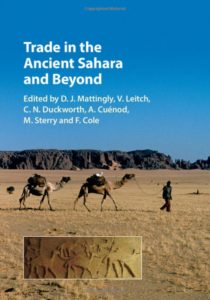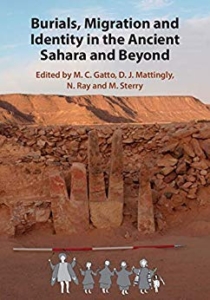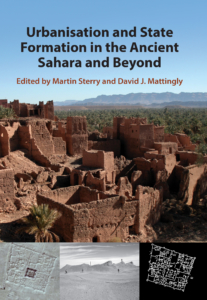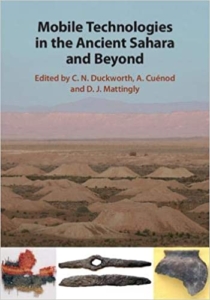The British Institute for Libyan and Northern African Studies has started a co-published series with Cambridge University Press.
The first series is a four-volume Trans-Sahara set (Series Editor: David Mattingly).
Vol 1: D. J. Mattingly, V. Leitch, C.N. Duckworth, A. Cuénod, M. Sterry, F. Cole. (eds) 2017.
Trade in the Ancient Sahara and Beyond.
Saharan trade has been much debated in modern times, but the main focus of interest remains the medieval and early modern periods. The pre-Islamic origins of Trans-Saharan trade have been hotly contested over the years, mainly due to a lack of evidence. However, new research on the Libyan people known as the Garamantes, and on their trading partners in the Sudan and Mediterranean Africa, requires us to revise our views substantially. In this volume experts re-assess the evidence for a range of goods, including beads, textiles, metalwork and glass, and use it to paint a much more dynamic picture, demonstrating that the pre-Islamic Sahara was a more connected region than previously thought.
For more information and to order a copy, click here
Vol 2: M.C. Gatto, D. J. Mattingly, N. Ray and M. Sterry (eds). 2019.
Burials, Migration and Identity in the Ancient Sahara and Beyond.
This volume presents the state of the field of funerary archaeology in the Sahara and its neighbouring regions and sets the agenda for future research on mobility, migration and identity. Burial traditions from various parts of the Sahara are compared and contrasted with those of the Nile Valley, the Maghreb and West Africa. It will be a seminal reference point for Mediterranean and African archaeologists, historians and anthropologists as well as archaeologists interested in burial and migration more broadly.
For more information and to order a copy, click here
Vol 3: M. Sterry and D. Mattingly (eds). 2020.
Urbanisation and State Formation in the Ancient Sahara and Beyond.
The themes of sedentarisation, urbanisation and state formation are fundamental ones in the archaeology of many diverse parts of the world but have been little explored in relation to early societies of the Saharan zone. Moreover, the possibility has rarely been considered that the precocious civilisations bordering this vast desert were interconnected by long-range contacts and knowledge networks. The orthodox opinion of many of the key oasis zones within the Sahara is that they were not created before the early medieval period and the Islamic conquest of Mediterranean North Africa. Major claims of this volume are that the ultimate origins of oasis settlements in many parts of the Sahara were considerably earlier, that by the first millennium AD some of these oasis settlements were of a size and complexity to merit the categorisation ‘towns’ and that a few exceptional examples were focal centres within proto-states or early state-level societies.
For more information and to order a copy, click here
Vol4: C. Duckworth, A. Cuénod, D. Mattingly (eds). 2020.
Mobile Technologies in the Ancient Sahara and Beyond
The ancient Sahara has often been treated as a periphery or barrier, but this agenda-setting book – the final volume of the Trans-Saharan Archaeology Series – demonstrates that it was teeming with technological innovations, knowledge transfer, and trade from long before the Islamic period. In each chapter, expert authors present important syntheses, and new evidence for technologies from oasis farming and irrigation, animal husbandry and textile weaving, to pottery, glass and metal making by groups inhabiting the Sahara and contiguous zones. Scientific analysis is brought together with anthropology and archaeology. The resultant picture of transformations in technologies between the third millennium BC and the second millennium AD is rich and detailed, including analysis of the relationship between the different materials and techniques discussed, and demonstrating the significance of the Sahara both in its own right and in telling the stories of neighbouring regions.
To read a review of this title in the American Journal of Archaeology, click here
For more information and to order a copy, click here







